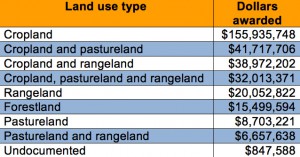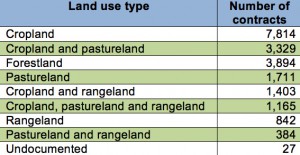Note: This is the second of several blog posts that summarizes initial data we are receiving from USDA National Resource Conservation Service (NRCS) on the Conservation Stewardship Program. You can read the first blog post in this series here.
In last week’s blog Update on the Conservation Stewardship Program – Part I we highlighted data on each of the first two sign-up periods of the Conservation Stewardship Program (CSP). In this post we continue in that vein and also provide some basic information on the program’s influence on how farmers, ranchers and forestland manage their land across the United States.
Allocation of CSP funding
Roughly $320 million (plus an additional $60 million for technical assistance) has been distributed to 20,567 farmers and ranchers across the US by the program after the first two sign-up years in 2009 and 2010. The $320 million represents the first year cost of the five-year contracts. Nearly half of total CSP financial assistance dollars went to farms that are entirely comprised of cropland. Another 35 percent went to farms that had a combination of cropland and either range or pasture or both. Payments to farms and ranches and woodlot operations that have no cropland accounted for 16 percent of total CSP financial assistance dollars in 2009 and 2010.
The figure below provides a breakdown of funding allocations by land-use type.
The average annual payment per acre (exclusive of technical assistance costs) for 2009 and 2010 combined was $12.73. Cropland had the highest average annual payment per acre of $22.76 and rangeland had the smallest annual payment per acre of $3.97.
The average annual payment per contract was $15,642. Farmers who received payments for both cropland and rangeland had the highest average annual contract payment of roughly $29,000. Forestland owners received the smallest average annual contract payment of $4,716.
Five states – Minnesota, Iowa, Nebraska, North Dakota and Kansas – received nearly one-third of total CSP funds (or ~ $100 million) over the first two years of the first two sign-up periods. Minnesota has received the largest proportion of CSP funding overall of any state. Farmers in that state have received $21 million in payments since 2009.
Nearly half of the contracts issued by the program since 2009 went to payments on cropland. Despite the relatively small average payments per acre and per contract for forestland, contracts to forestland owners represent 18 percent of total contracts awarded.
The table below outlines the number of contracts issued for each land-use type.
Allocation of CSP acreage
Over 25 million acres of land was enrolled in CSP in 2009 and 2010 combined. This pie chart shows the breakdown of treated acres by land-use type. The majority of acres t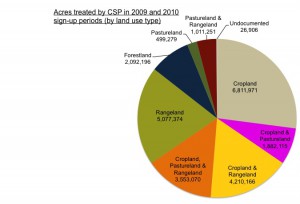 reated by the program so far have been cropland and rangeland, though with a healthy amount of pasture and forested land as well. The 12.8 million acres available for CSP enrollment each year is allocated to the states in proportion to each state’s total agricultural land area compared to the US total.
reated by the program so far have been cropland and rangeland, though with a healthy amount of pasture and forested land as well. The 12.8 million acres available for CSP enrollment each year is allocated to the states in proportion to each state’s total agricultural land area compared to the US total.
Texas, Nebraska and Montana enroll the greatest number of acres in the program, each of them with significant cropland and substantial rangeland. Counting the 2009 and 2010 enrollments, farmers and ranchers in these three states together have implemented conservation activities on over 5 million acres of land through CSP. The table below highlights the top ten states for acreage enrollment in CSP for both the 2009 and 2010 sign-up periods.
In Texas the majority of 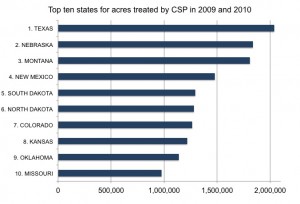 CSP acres were enrolled as rangeland, while Montana enrolled farmers who predominately implemented conservation practices on a combination of pastureland, rangeland and cropland. The majority of contracts issued in Nebraska were for farms with both cropland and rangeland.
CSP acres were enrolled as rangeland, while Montana enrolled farmers who predominately implemented conservation practices on a combination of pastureland, rangeland and cropland. The majority of contracts issued in Nebraska were for farms with both cropland and rangeland.
Farms with commodity crops dominate contract numbers
Farmers that grow corn, forage/hay, wheat, and soybeans on their farms received the lion’s share of CSP contracts. The table below summarizes the number of contracts issued for various commodity types. Note that data on dollars allocated or acres treated for particular commodities was not available at the time that this blog was published; hence we are only showing contract numbers, by predominate activity per farm.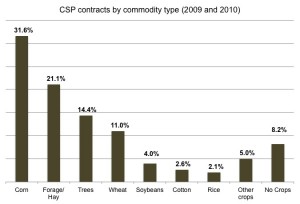
Among farms with livestock, beef and dairy represent that vast majority of total contracts.
Practices and enhancements most popular with farmers and ranchers
In the 2009 and 2010 enrollment years, the conservation enhancements chosen most frequently by farmers on cropland were:
- reducing pesticide drift;
- GPS and electronic control technology for chemical application;
- plant tissue testing for nitrogen management;
- wildlife-sensitive haying;
- split nitrogen applications;
- advanced integrated pest management;
- precision nutrient application;
- continuous no-till with residue management;
- resource-conserving crop rotations;
- cover crop mixtures; and
- pollinator habitat.
For pasture and rangeland, leading enhancements chosen by grazers and ranchers included:
- rotation of feeding and supplementation areas;
- retrofitting water facilities for wildlife escape;
- grazing management to improve wildlife habitat;
- monitoring to improve grazing management;
- incorporating native grasses and legumes into forage base;
- management intensive rotational grazing; and
- solar powered electric fencing.
For forestland, the leading enhancements chosen by family foresters were:
- forest stand improvement for wildlife habitat and soil quality;
- forest wildlife structures;
- riparian forest buffers;
- prescribed burning;
- hardwood crop tree release; and
- pollinator habitat.
Wildlife habitat enhancements come up big
Over 15,0000 conservation enhancements and practices specifically designed for wildlife habitat benefits were included in 2009 and 2010 contracts. This is about 20 percent of the total conservation enhancements and practices selected in the two initial sign-ups and does not include the many additional enhancements designed for other primary purposes (such as reducing pesticide use and nutrient runoff, conserving water, or increasing biodiversity) with positive indirect wildlife benefits.
Other intriguing enhancement choices
In the first two years, 350 farmers chose to convert cropland to grass-based agriculture and nearly 450 chose to implement continuous cover crop systems. Over 500 chose to adopt non-chemical control of weeds and invasives on grasslands. Enhancements that are specific to organic farming systems were chosen in 210 contracts; this does not count all of the other conservation practices highly relevant to, but not specific to, organic systems, such as crop rotation, cover cropping, composting, and habitat for beneficials and pollinators. Nearly 200 farmers and ranchers chose to participate in on-farm research and demonstration or on-farm innovative practice pilot testing projects.
Top ranking enhancements
CSP conservation enhancements are ranked according to expected environmental benefits. The higher the environmental benefit score, the higher the CSP payment. The top dozen highest-scoring enhancements are:
- conversion of cropped land to grass-based agriculture for biomass or forage production;
- continuous no-till for organic farming systems;
- continuous cover crops;
- continuous no-till with residue management;
- riparian forest buffer extension;
- resource-conserving crop rotations;
- 100 percent on-farm nitrogen sources;
- herbaceous riparian buffer extension;
- legume cover crops for on-farm nitrogen;
- rotation of livestock feeding and supplementation areas;
- prairie restoration; and
- filter strip extension.
CSP program update – part three
Part three of this blog series will highlight participation of specialty crop producers and beginning, social disadvantaged, and limited resource farmers and ranchers in the program and how their participation differs from the general farmer population. It will also include information on CSP participation via special area wide project-based approaches.


